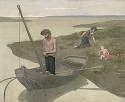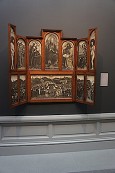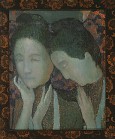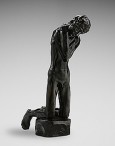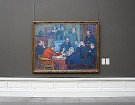The browser will either open the file, download it, or display a dialog.
Minne-Maeterlinck: The World of George Minne and Maurice Maeterlinck
Museum voor Schone Kunsten, Ghent, Belgium
October 22, 2011 – February 19, 2012
Catalogue:
De wereld van George Minne & Maurice Maeterlinck / L'univers de George Minne & Maurice Maeterlinck.
Edited by Robert Hoozee and Cathérine Verleysen, with essays by Robert Hoozee, Denis Laoureux, Cathérine Verleysen, Inga Rossi-Schrimpf, and Marian Bisanz-Prakken.
Ghent and Brussels: Museum voor Schone Kunsten in association with Mercatorfonds, 2011.
254 pp.; 205 color illustrations; 16 black and white illustrations; selected bibliography.
€ 30.00 (hardcover French and Dutch edition)
ISBN 978-90-6153-356-6
On October 22, 1911, the Belgian symbolist poet, playwright and essayist Maurice Maeterlinck (1862–1949) was awarded the Nobel Prize in Literature. To celebrate the centenary of this occasion, the Museum of Fine Arts in Ghent held an exhibition on Maurice Maeterlinck and the artist George Minne (1866–1941). Both were prominent figures in the Belgian Symbolist art scene of the late nineteenth century. Symbolist art was committed to purity of form and preoccupied with matters of feeling and inner life. Symbolist artists aspired to express the core of things, the Idea.[1] They were concerned with l'au-delà, the inexpressible, a deeper truth that is to be found behind the merely external (98). Both Maeterlinck and Minne were much appreciated for their ability, each in their own way, to lay bare the innermost depths of the soul by way of a direct visual language. According to Maurice Maeterlinck (1862–1949), George Minne had an extraordinary talent for expressing the gestures and attitudes of sorrow (20). Maeterlinck considered Minne to be his âme soeur, his soul-mate.[2] In Minne, Maeterlinck recognized his counterpart in the visual arts. The exhibition entitled The World of George Minne & Maurice Maeterlinck explores the relationship between the author and the artist, who were both living and working in Ghent in the late 1880’s.
The title The World of George Minne & Maurice Maeterlinck was a clever concept for it enabled the curators to address the actual correlation between Minne and Maeterlinck, while at the same time exploring their influence on others both within and outside of Belgium. The introductory panel states the objective of the exhibition: “This exhibition follows the development of George Minne, looks for connections with Maeterlinck, and outlines the influence of both artists on the Symbolist art of their time.” The curators have lived up to their aim. First, the exhibition explores the actual correlation between the writer and the artist, as well as their shared inspiration by artists like Auguste Rodin and Odilon Redon. Then, the visitor enters the “world” of Maeterlinck, who was an influential figure in the avant-garde art scene in Paris; and finally, in the three smaller spaces of the five galleries, the exhibition is devoted to Minne’s “world.” In each of these five galleries, artworks in several media are on display, including sculpture, printed books, graphic art, paintings, and drawings. Each room contains a monumental eye-catcher as well as one or more pieces of refined graphic art or an illustrated book that demands close attention.
The first room is the most important one, because it deals with the actual correlation between Minne and Maeterlinck. Visitors enter a large space with high ceilings provided with natural overhead light, which lend a pleasant feel to the exhibition space (fig. 1). They are welcomed by Minne’s early sculpture, Man and Woman Kneeling (1889), a forerunner of his later series of kneeling youths (fig. 2). Attention is then drawn to the eye-catcher The Poor Fisherman (1881) by Pierre Puvis de Chavannes who was of great influence on the generation of Symbolists to which Minne and Maeterlinck belonged (fig. 3). The Poor Fisherman is followed by the work of other important predecessors like the Pre-Raphaelite Edward Burne-Jones and Odilon Redon. Maeterlinck owned an edition of Redon’s album of six lithographs entitled Hommage à Goya (1885) (25) (fig. 4).
In the back of the room, a couple of Minne’s early sculptures are displayed. A distinctive feature of Minne’s oeuvre is the repetition of a limited number of subjects, one of which is that of a mother grieving over her dead child. According to Ferdinand Hodler, who was deeply involved in Symbolism and Art Nouveau during the 1890’s, “The most intimate conditions of the soul are made externally perceptible by bodily posture […] Form brings every human physiognomy to expression and reveals man’s inner condition.”[3] This is exactly what Minne achieved with the three versions of a mother grieving over her dead child(ren) put on display here (fig. 5). The choice to combine them with Minne’s drawings of the same subject is a fine one, aptly conveying the artist’s involvement in certain themes (fig. 6). In addition, his sculptures are juxtaposed with The Death of Alcestes by Auguste Rodin, by whom Minne’s work is informed (fig. 7). Also included is a ceramic piece by Paul Gauguin and two plaster statues by Constantin Meunier, two artists who, like Minne, rejected ornament in favor of simplified volumes and clearly defined outlines (fig. 8).[4]
Symbolism aspired to a closer relationship between text and image, with literature and the visual arts closely intertwined. And where text and image were combined, the images are not merely illustrations. In a free associative manner, they evoked the same themes as the poems and prose. Between 1886 and 1890, George Minne was active as an illustrator of books by authors like Grégoire Le Roy, Maurice Maeterlinck, and Charles van Lerberghe (20). It was in fact through this practice of illustration that Minne became immersed in Symbolism, eventually becoming one of the protagonists of this movement. Ten display cases situated in the middle of the room, shielded from the light by a huge black canopy, exhibit this cooperation between artists like Minne and these literary figures (fig. 9). Executed in a linear style, Minne provided illustrations for Mon coeur pleure d'autrefois (1889) by Grégoire Le Roy; Maeterlinck’s Serres chaudes (Greenhouses) (1889), La Princesse Maleine (1889), and Alladine et Palomides, Intérieur, and La Mort de Tintagiles: Trois Petits Drames pour marionnettes (all 1894); and Emile Verhaeren’s Villages Illusoires (1895) (56). Maurice Maeterlinck’s collection of poems entitled Serres chaudes (Greenhouses) was first published in 1889 (fig. 10). It was printed by Louis van Melle in Ghent on Van Gelder paper in an edition of 125 copies. The text was accompanied by a frontispiece, five illustrations and a decorative tailpiece at the end of the book by Minne.[5] Minne’s illustrations for Serres chaudes are imbued by the same mixture of anguish and melancholic passivity as expressed in Maeterlinck’s poems.[6]
Before entering the second large gallery, visitors pass through a corridor where a reproduction of Hubert and Jan Van Eyck’s Ghent Altarpiece is hanging (fig. 11). The accompanying text explains that Flemish Primitive art was a very important source of reference for the Symbolists, including Maeterlinck who owned a reproduction of the Ghent Altarpiece, which hung above his bed. Although this is an engaging piece of information, I believe this very important influence on the Symbolists, treated literally “in passing,” deserves more attention, especially since the museum has more than enough pieces in its permanent collection to do so. As it is, the reproduction really stands on its own, which makes it an oddity in the exhibition.
In the second gallery, which is of the same large size as the first, visitors almost completely lose track of George Minne. This room is devoted to Maeterlinck’s influence on the Parisian avant-garde art scene (fig. 12). Plays by Maeterlinck were performed by theatre groups like Théâtre de l’Oeuvre and Théâtre de l’Art, which caused symbolist Nabis artists like Maurice Denis to be inspired by the Flemish playwright (107–108) (fig. 13). Maeterlinck became increasingly successful and once again, he turned to Minne for illustrations for the German edition of Soeur Béatrice (Sister Beatrice). This is the only work by Minne to be found in this room.
The Parisians were not the only ones inspired by Maeterlinck’s writings; he was also an important point of reference for Belgian artists. One of those was Léon Spilliaert, who considered Maeterlinck to be “the author expressing indefinable feelings of anxiety and insecurity, to which he was susceptible himself” (125). And it is definitely Spilliaert who steals the show in this room, both on the walls and in the showcases. The copy of a three-volume collection of Maeterlinck’s plays, hand-illustrated by Spilliaert with 348 drawings in India ink, gouache, and pastel, is absolutely beautiful, as are his series of lithographs inspired by Maeterlinck’s Serres chaudes (figs. 14 and 15).
An incongruity is the five landscapes, one by Auguste Donnay, two by Fernand Khnopff, and two by William Degouve de Nuncques (fig. 16). Whether or not informed by Maeterlinck in style and subject, in this case the heterogeneity enabled by the exhibition title The World of . . . does not work out for the better. It must be said that this second room as a whole is rather unbalanced. Various artists, like Antoon van Welie, Xavier Mellery, and Jean Delville, are represented by only one work. In addition to the heterogeneity in purpose—ranging from theatre programs to highbrow paintings—and diversity in sizes, frames, and the techniques, this resulted in an overall feel of unsatisfactory instability.
Stability is regained in the third room. We now bid goodbye to Maeterlinck—the visitor will see no more of him. Attention fully turns to Minne’s development as a sculptor and his influence on the German and Viennese art worlds. We enter an oddly shaped triangular room, which must have been hard to design for the exhibition. With the exception of one piece by Meunier, it is completely devoted to Minne’s burst of creativity during the years he spent in Vorst, Belgium (1896–99) (fig. 17).[7] Half of the sculptures are placed on pedestals, the other half are displayed in two showcases. Here some of Minne’s best-known sculptures can be found, for example The Prodigal Son (1896) and the Small Relic Bearer (1897). Juxtaposing Man with a Waterskin to The Bricklayer (1897) may be an obvious decision, but the effect is beautiful (fig. 18).
The most striking motif in George Minne's oeuvre is that of the kneeling figure. This motif came into being in the late 1890’s. It has been said that Minne’s youths are images built up out of souls, skin, and bones.[8] The quiet, introverted boys embody the hardship of being. Isolating themselves for the sake of total introspection by clasping their arms round their bodies, they reflect an image of the soul suffering from the turmoil of modernity.[9] On display here are John the Baptist (1895) and Small Figure Kneeling (1896). These two sculptures mark the first steps in Minne’s treatment of the theme of the kneeling figure; in fact John the Baptist was crucial in Minne’s development towards the Kneeling Youth of the Fountain (fig. 19). The pose of the figure and the gesture of the arms are already very much like those of the kneeling youths. The big difference is that this work is still very much individualized and it has a strong medieval feel to it. John the Baptist was followed by the prototype of Minne’s kneeling youths, called the Small Figure Kneeling (1896) (fig. 20). The face of this boy still resembles that of the earlier John the Baptist and still has personalized features.[10] In the following years, the kneeling figure becomes depersonalized and increasingly about the general concept of suffering and melancholia. What is so intriguing about Minne’s sculptures is the degree of expressiveness he was able to evoke. This was accomplished by an ever more restrained modeling of the sharply outlined slender shapes of the half-grown men, ultimately resulting in the famous Fountain with Kneeling Youths.
However, before we turn to Minne’s famous fountain, attention must be paid to the first of two rooms devoted to the reception of Minne in Germany and Austria. Absolutely marvelous is Ossip Zadkine’s wooden sculpture entitled The Misery of Job (1914), an extraordinary piece that demands all attention (fig. 21). It is intriguing how Zadkine has managed to adjust the anatomy of his carved figures to the grain of the wood so perfectly. He has taken Minne’s restrained modeling to a whole new level of abstraction, which very much adds to the expressiveness of the work. Unfortunately, this sculpture is not given enough space. And even more problematic, Zadkine’s piece is so overpowering that everything else in the room is lost in comparison. Wilhelm Lehmbruck’s etchings and busts cannot compete, and Gustave Klimt’s delicate drawings are completely lost (fig. 22). Only Schiele’s portrait of his sister Gerti in stark red and orange stands strong enough to compete with the Zadkine sculpture (fig. 23). Thus, even though this room contains the strongest piece of the exhibition, from a museological standpoint, the room as a whole is a disappointment. This recurrent lack of balance between the displayed works is the biggest letdown in The World of George Minne & Maurice Maeterlinck. In fact, four tiny exhibitions are combined under the banner of The World of. . . . One is about the correlation between Minne and Maeterlinck, one is about Maeterlinck as an inspiration for Parisian and Belgian artists, one is about Minne’s development as a sculptor, and one is about Minne’s influence on the German and Austrian art world. The convenient title The World of . . . offers many opportunities to explore Minne and Maeterlinck, but it also gives the exhibition as a whole an all too heterogeneous character. The clever concept turns out to be a pitfall.
The fifth and final gallery is also devoted to Minne’s influence on the Germans and Austrians. Here we find Minne’s famous Fountain with Kneeling Youths: Kneeling Youths (1898), as well as the best known separate kneeling figure, Kneeling Youth (1898) and the slightly later Large Figure Kneeling (1898) (fig. 24). Over time, Minne achieved a perfect balance in his sculpture between the formal aspects of his restrained modeling and linear focus on the one hand, and the expressive elements and spiritual concerns of Symbolism on the other hand.[11] Kneeling Youth is considered to be the culmination of this (fig. 25). This version of the kneeling figure was placed around a basin defined by five identical figures to form the Fountain with Kneeling Youths (fig. 26). Because of this replication, the introversion and suffering that the figure conveys is intensely magnified.[12]
The showcases displaying the reception of Minne in Germany and Vienna are also instructive. “The first sculpture of the new age” is how the influential German art critic Julius Meier-Graefe described George Minne’s Kneeling Youth in Ver Sacrum (fig. 27). On the occasion of Minne’s participation in the eighth Secession exhibition in Vienna in 1900, the second issue of Ver Sacrum was dedicated to the artist’s work. Germany and Austria proved to be fertile grounds for George Minne. Thanks to an increasing interest in the applied arts, a revaluation of the Gothic style, the emergence of the Jünglingskult, and more attention towards inner life, Minne’s art became very popular in Germany and Austria (181). His sculptures were appreciated for their expressiveness and their linear ornamental quality that resembled Jugendstil. In fact, Minne was conceived not as a Symbolist artist, but as a pre-expressionist Jugendstil artist (181). And his work actually functioned as a bridge leading towards expressionism. Minne was a very important source of inspiration for expressionist artists like Oskar Kokoschka, Wilhelm Lehmbruck, and Egon Schiele. In the fifth room, Minne’s sculptures are countered by Oskar Kokoschka’s brightly colored series of eight colored lithographs entitled Die träumenden Knaben (The Dreaming Youths, 1906–08) (fig. 25). The Dreaming Youths is a long poem combined with illustrations that was described by the artist as an account of the condition of his soul during adolescence (fig. 28).[13] It marks his transition from childhood to adulthood. The figures in the lithograph entitled Das Mädchen Li und Ich (The Girl Li and I) strongly resemble Minne’s slender youths (fig. 29). Just like the kneeling figures, Kokoschka’s adolescents embody vulnerability and introversion. Minne’s kneeling figures have helped shape the expressionist’s conception of the relation between inner life and the form through which it is articulated (190). I am very much looking forward to the forthcoming PhD thesis by Inga Rossi-Schrimpf, who contributed a very interesting article on the subject to the exhibition catalogue (180–207).
At the turn of the century, many progressive intellectuals and socialites portrayed themselves in personal surroundings that included a sculpture by Minne. Carl Moll’s Self-portrait in the Studio (ca. 1906), for instance, contains one of Minne’s kneeling figures in the foreground (fig. 30). As Minne became increasingly popular in the German-speaking world, his Symbolist compatriots did not forget about him. Theo van Rysselberghe’s The Reading (1903), which includes Maurice Maeterlinck (far right), pays tribute to George Minne (fig. 31): a Small Kneeling Youth is standing on the mantelpiece in front of the mirror in the background (135). Surprisingly, this painting was not incorporated in the exhibition, although it is on display in the museum, and visitors pass it before entering the exhibition. The tendency to include Minne’s artworks in paintings and photographs to express one’s progressive state of mind shows how important and appreciated Minne really was during his lifetime. This is why we must be thankful to Robert Hoozee for reinstating George Minne with a survey of his work in 1982. Sadly, the museum director of Ghent’s Museum of Fine Arts died on February 21, 2012, just two days after the closing of The World of George Minne & Maurice Maeterlinck. It is symbolic that his final exhibition was once more about Minne. The exhibition and accompanying catalogue mark a great progression in the interpretation of Minne’s importance to the fin-de-siècle art world.
Lisa Smit
MA Arts Studies, University of Amsterdam
Some parts of this review were originally written as part of an essay for the MA-course “Public, Mediators, Artists. The Riddle of the Crystal Palace and its Legacies” taught by Professor Doctor Deborah A. Cherry and Doctor Bram van Oostveldt at the University of Amsterdam.
[1] Carel Blotkamp et al., Kunstenaren der idee: Symbolistische tendenzen in Nederland, ca. 1880–1930 (The Hague: Haags Gemeentemuseum, 1978), 14.
[2] Albert Alhadeff, “Spiritualisme en zelfvertering in Minnes 'Jongeling’ and 'De kleine gekwetste’” in 200 jaar verzamelen: Collectieboek Museum voor Schone Kunsten Gent, ed. Arnout Balis (Ghent: Ludion, 2000), 182.
[3] Ferdinand Hodler, “Characteristic Expression through Form” in Art in Theory, 1815-1900: An Anthology of Changing Ideas, eds. Charles Harrison, Paul J. Wood, and Jason Gaiger (Oxford, UK: Blackwell Publishers Ltd., 1998), 1061.
[4] Francine-Claire Legrand, Symbolism in Belgium (Brussels: Imprimerie Laconti, 1972), 153.
[5] George Minne en de kunst rond 1900, eds. Robert Hoozee et al., exh. cat. (Ghent: Museum voor Schone Kunsten, 1982), 87.
[6] Legrand, Symbolism in Belgium, 159.
[7] George Minne en de kunst rond 1900, 17–21.
[8] Arthur Roessler, “George Minne,” Deutsche Kunst und Dekoration 25, 4 (1910): 242.
[9] Legrand, Symbolism in Belgium, 156.
[10] George Minne en de kunst rond 1900, 116–19.
[11]Impressionism to Symbolism: The Belgian Avant-Garde 1880-1900, eds. MaryAnne Stevens and Robert Hozee, exh. cat. (London: Royal Academy of the Arts, 1994), 24.
[12] Lynne Pudles, “The Symbolist Work of George Minne,” Art Journal 45, 2 (1985): 126.
[13] Oskar Kokoschka, Mein Leben (Vienna: Metroverlag, 2008), 52.




